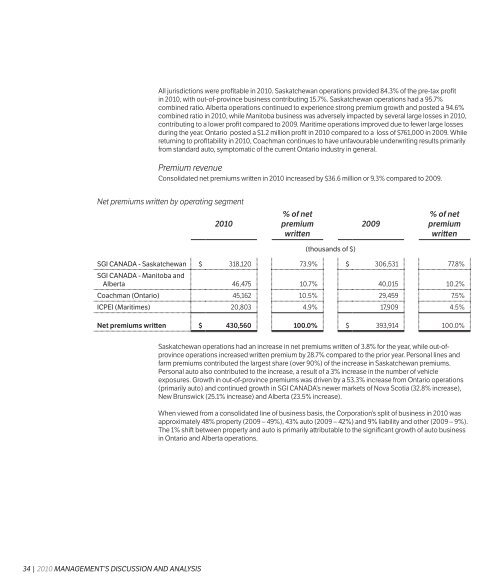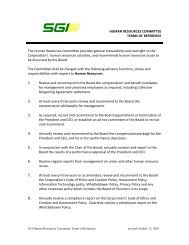Full report - SGI Canada
Full report - SGI Canada
Full report - SGI Canada
You also want an ePaper? Increase the reach of your titles
YUMPU automatically turns print PDFs into web optimized ePapers that Google loves.
Transaction costs are included in the acquisition cost of individual investments. Direct investment<br />
expenses, such as external custodial, investment management and investment consultant expenses, are<br />
recorded against investment earnings.<br />
When the fair value of an investment falls below its cost, and the decline is determined to be other than<br />
temporary, a loss equivalent to the difference between cost and fair value is recorded in investment<br />
earnings as an investment write-down.<br />
Foreign currency translation<br />
Monetary assets and liabilities denominated in foreign currency are translated at the exchange rate in<br />
effect at the year-end date. Revenues and expenses are translated at the exchange rate in effect at the<br />
transaction date. Unrealized gains and/or losses arising on translation are charged to operations in<br />
the current year. Unrealized foreign exchange gains and/or losses arising on investments designated<br />
as available for sale are included in other comprehensive income until realized, at which time they are<br />
reclassified from accumulated other comprehensive income to investment earnings. Translation gains<br />
and/or losses related to other financial assets and liabilities are charged to operations in the current year.<br />
Premiums<br />
Premiums written are taken into income over the terms of the related policies, no longer than 12 months.<br />
Unearned premiums represent the portion of the policy premiums relating to the unexpired term of each policy.<br />
Provision for unpaid claims<br />
The provision for unpaid claims represents an estimate of the total cost of outstanding claims at the yearend<br />
date. The estimate includes the cost of <strong>report</strong>ed claims, and claims incurred but not <strong>report</strong>ed, and<br />
an estimate of adjustment expenses to be incurred on these claims. The provision is calculated without<br />
discounting, except for long-term disability claims. The estimates are necessarily subject to uncertainty<br />
and are selected from a range of possible outcomes. During the life of the claim, adjustments to the<br />
estimates are made as additional information becomes available. The change in outstanding losses plus<br />
paid losses is <strong>report</strong>ed as claims incurred in the current period.<br />
Reinsurance ceded<br />
Reinsurance premiums ceded and reinsurance recoveries on losses incurred are recorded as reductions<br />
of the respective income and expense accounts.<br />
Unpaid claims recoverable from reinsurers, reinsurers’ share of unearned premiums and unearned<br />
reinsurance commissions are estimated in a manner consistent with the method used for determining the<br />
provision for unpaid claims, unearned premiums and deferred policy acquisition costs respectively.<br />
Income taxes<br />
The Corporation uses the asset and liability method of accounting for income taxes. Current income taxes<br />
are recognized as estimated income taxes payable for the current year. Future income tax assets and<br />
liabilities consist of temporary differences between tax and accounting bases of assets and liabilities, as<br />
well as the benefit of losses available to be carried forward to future years for tax purposes that are likely to<br />
be realized. The effect on future tax assets and liabilities of a change in tax rates is recognized in income<br />
in the period that includes the date of enactment or substantive enactment. A valuation allowance is<br />
recorded against any future income tax asset if it is more likely than not that the asset will not be realized.<br />
Employee future benefits<br />
The Corporation provides a defined benefit pension plan and a defined contribution pension plan that<br />
provide retirement benefits for its employees.<br />
Under the defined contribution pension plan, the Corporation’s obligations are limited to contributions<br />
made for current service. When made, these contributions are charged to income.<br />
For the defined benefit plan:<br />
i. For the purpose of calculating the expected return on plan assets, those assets are valued at fair<br />
value, which approximates market value.<br />
ii.<br />
Pension obligations are determined by an independent actuary using the projected benefit method<br />
prorated on service and management’s best estimate assumptions of expected plan investment<br />
performance, salary escalation, age at retirement, mortality of members and future pension indexing,<br />
based upon the consumer price index.<br />
iii. The discount rate used to determine the accrued benefit obligation was determined by reference<br />
to market interest rates at the measurement date of high-quality debt instruments with cash flows<br />
that match the timing and amount of expected benefit payments.<br />
iv. Past service costs from plan amendments and the transitional asset are amortized on a straight-line<br />
basis over a period of time, which is a blending of the expected average remaining service lifetime of<br />
the active members and the future life expectancy of the pensioners.<br />
v. The excess of the net actuarial gain (loss) over 10% of the greater of the accrued benefit<br />
obligation and the fair value of the plan assets is amortized over a period of time, which is a blending<br />
of the expected average remaining service lifetime of the active members and the future life<br />
expectancy of the pensioners.<br />
The Corporation provides defined benefit service recognition plans for both management and in-scope<br />
(union) employees for the purpose of providing certain retirement benefits. The cost of the plans is<br />
determined using the projected benefit method prorated on service.<br />
Cash and cash equivalents<br />
Cash and cash equivalents consist of money market investments with a maturity of 90 days or less from the<br />
date of acquisition, and are presented net of cash on hand less outstanding cheques.<br />
Deferred policy acquisition costs<br />
Premium taxes, commissions and certain underwriting and policy issuance costs are charged to expense<br />
over the terms of the insurance policies to which such costs relate. The method followed in determining<br />
the deferred policy acquisition costs limits the amount of the deferral to the amount recoverable from<br />
unearned premiums after giving consideration to investment income, as well as claim and adjustment<br />
expenses expected to be incurred as the premiums are earned.<br />
Net investment in capital lease<br />
Investment earnings related to the direct financing lease are recognized in a manner that produces a<br />
constant rate of return on the investment in the lease. The net investment in the lease is composed of net<br />
minimum lease payments less unearned finance income.<br />
68 | 2010 NOTES TO THE CONSOLIDATED FINANCIAL STATEMENTS NOTES TO THE CONSOLIDATED FINANCIAL STATEMENTS 2010 | 69















